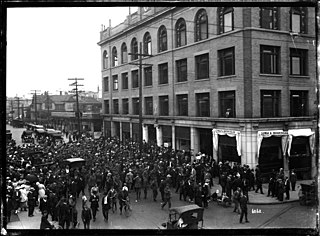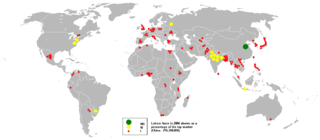Labour laws are those that mediate the relationship between workers, employing entities, trade unions, and the government. Collective labour law relates to the tripartite relationship between employee, employer, and union.
Employment is a relationship between two parties regulating the provision of paid labour services. Usually based on a contract, one party, the employer, which might be a corporation, a not-for-profit organization, a co-operative, or any other entity, pays the other, the employee, in return for carrying out assigned work. Employees work in return for wages, which can be paid on the basis of an hourly rate, by piecework or an annual salary, depending on the type of work an employee does, the prevailing conditions of the sector and the bargaining power between the parties. Employees in some sectors may receive gratuities, bonus payments or stock options. In some types of employment, employees may receive benefits in addition to payment. Benefits may include health insurance, housing, disability insurance. Employment is typically governed by employment laws, organisation or legal contracts.
Overtime is the amount of time someone works beyond normal working hours. The term is also used for the pay received for this time. Normal hours may be determined in several ways:

A domestic worker or domestic servant is a person who works within the scope of a residence. The term "domestic service" applies to the equivalent occupational category. In traditional English contexts, such a person was said to be "in service". Domestic workers perform a variety of household services for an individual, from providing cleaning and household maintenance, or cooking, laundry and ironing, or care for children and elderly dependents, and other household errands.
An employment contract or contract of employment is a kind of contract used in labour law to attribute rights and responsibilities between parties to a bargain. The contract is between an "employee" and an "employer". It has arisen out of the old master-servant law, used before the 20th century. Employment contracts relies on the concept of authority, in which the employee agrees to accept the authority of the employer and in exchange, the employer agrees to pay the employee a stated wage.

The rights and duties for employees, labor unions, and employers are set by labor law in the United States. Labor law's basic aim is to remedy the "inequality of bargaining power" between employees and employers, especially employers "organized in the corporate or other forms of ownership association". Over the 20th century, federal law created minimum social and economic rights, and encouraged state laws to go beyond the minimum to favor employees. The Fair Labor Standards Act of 1938 requires a federal minimum wage, currently $7.25 but higher in 29 states and D.C., and discourages working weeks over 40 hours through time-and-a-half overtime pay. There are no federal laws, and few state laws, requiring paid holidays or paid family leave. The Family and Medical Leave Act of 1993 creates a limited right to 12 weeks of unpaid leave in larger employers. There is no automatic right to an occupational pension beyond federally guaranteed Social Security, but the Employee Retirement Income Security Act of 1974 requires standards of prudent management and good governance if employers agree to provide pensions, health plans or other benefits. The Occupational Safety and Health Act of 1970 requires employees have a safe system of work.
Labor rights or workers' rights are both legal rights and human rights relating to labor relations between workers and employers. These rights are codified in national and international labor and employment law. In general, these rights influence working conditions in the relations of employment. One of the most prominent is the right to freedom of association, otherwise known as the right to organize. Workers organized in trade unions exercise the right to collective bargaining to improve working conditions.

Saudization, officially the Saudi nationalization scheme and also known as Nitaqat, is a policy that is implemented in the Kingdom of Saudi Arabia by the Ministry of Labor and Social Development, which requires companies and enterprises to fill their workforce with Saudi nationals up to certain levels.
Japanese labour law is the system of labour law operating in Japan.

Labor relations is a field of study that can have different meanings depending on the context in which it is used. In an international context, it is a subfield of labor history that studies the human relations with regard to work in its broadest sense and how this connects to questions of social inequality. It explicitly encompasses unregulated, historical, and non-Western forms of labor. Here, labor relations define "for or with whom one works and under what rules. These rules determine the type of work, type and amount of remuneration, working hours, degrees of physical and psychological strain, as well as the degree of freedom and autonomy associated with the work." More specifically in a North American and strictly modern context, labor relations is the study and practice of managing unionized employment situations. In academia, labor relations is frequently a sub-area within industrial relations, though scholars from many disciplines including economics, sociology, history, law, and political science also study labor unions and labor movements. In practice, labor relations is frequently a subarea within human resource management. Courses in labor relations typically cover labor history, labor law, union organizing, bargaining, contract administration, and important contemporary topics.
The Labor Code of the Philippines is the legal code governing employment practices and labor relations in the Philippines. It was enacted on Labor day, May 1, 1974 by Late President of the Philippines Ferdinand Marcos in the exercise of his then extant legislative powers.
Labour in India refers to employment in the economy of India. In 2020, there were around 476.67 million workers in India, the second largest after China. Out of which, agriculture industry consist of 41.19%, industry sector consist of 26.18% and service sector consist 32.33% of total labour force. Of these over 94 percent work in unincorporated, unorganised enterprises ranging from pushcart vendors to home-based diamond and gem polishing operations. The organised sector includes workers employed by the government, state-owned enterprises and private sector enterprises. In 2008, the organised sector employed 27.5 million workers, of which 17.3 million worked for government or government owned entities. The Human Rights Measurement Initiative finds that India is only doing 43.9% of what should be possible at its level of income for the right to work. Employees are routinely taken advantage of by their employers because of loose labour laws across all industries in India.
A work permit or work visa is the permission to take a job within a foreign country.

Indian labour law refers to law regulating labour in India. Traditionally, the Indian government at the federal and state levels has sought to ensure a high degree of protection for workers, but in practice, this differs due to the form of government and because labour is a subject in the concurrent list of the Indian Constitution. The Minimum Wages Act 1948 requires companies to pay the minimum wage set by the government alongside limiting working weeks to 40 hours. Overtime is strongly discouraged with the premium on overtime being 100% of the total wage. The Payment of Wages Act 1936 mandates the payment of wages on time on the last working day of every month via bank transfer or postal service. The Factories Act 1948 and the Shops and Establishment Act 1960 mandate 15 working days of fully paid vacation leave each year to each employee with an additional 7 fully paid sick days. The Maternity Benefit (Amendment) Act, 2017 gives female employees of every company the right to take 6 months' worth of fully paid maternity leave. It also provides for 6 weeks worth of paid leaves in case of miscarriage or medical termination of pregnancy. The Employees' Provident Fund Organisation and the Employees' State Insurance, governed by statutory acts provide workers with necessary social security for retirement benefits and medical and unemployment benefits respectively. Workers entitled to be covered under the Employees' State Insurance are also entitled to 90 days worth of paid medical leaves. A contract of employment can always provide for more rights than the statutory minimum set rights. The Indian parliament passed four labour codes in the 2019 and 2020 sessions. These four codes will consolidate 44 existing labour laws. They are: The Industrial Relations Code 2020, The Code on Social Security 2020, The Occupational Safety, Health and Working Conditions Code, 2020 and The Code on Wages 2019.
Qatar is a transit and destination country for men and women subjected to trafficking in persons, specifically forced labor and, to a much lesser extent, forced prostitution. Men and women from Nepal, India, Pakistan, Bangladesh, the Philippines, Indonesia, Vietnam, Sri Lanka, Ethiopia, Sudan, Thailand, Egypt, Syria, Jordan, and China voluntarily travel to Qatar as laborers and domestic servants, but some subsequently face conditions indicative of involuntary servitude. These conditions include threats of serious physical or financial harm; job switching; the withholding of pay; charging workers for benefits for which the employer is responsible; restrictions on freedom of movement, including the confiscation of passports and travel documents and the withholding of exit permits; arbitrary detention; threats of legal action and deportation; false charges; and physical, mental, and sexual abuse. In some cases, arriving migrant workers have found that the terms of employment in Qatar are wholly different from those they agreed to in their home countries. Individuals employed as domestic servants are particularly vulnerable to trafficking since they are not covered under the provisions of the labor law. A small number of foreign workers transit Qatar and are forced to work on farms in Saudi Arabia. Qatar is also a destination for women who migrate and become involved in prostitution, but the extent to which these women are subjected to forced prostitution is unknown. Children have been used in Qatar and other Gulf countries as camel jockies. Most children are trafficked from Africa and South Asia. This practice has ceased in most areas though. Workers have been forced to work in bad conditions; their salaries are sometimes withheld.

A thirteenth salary, or end-of-year bonus, is an extra payment given to employees at the end of December. Although the amount of the payment depends on a number of factors, it usually matches an employee's monthly salary and can be paid in one or more installments. The thirteenth salary is most prominent in Latin America, where this payment is mandatory in most countries. In countries where the bonus is required by law, all employees usually receive it if they have worked for the company for a certain required amount of time. However, freelancers and contract workers are often not entitled to receive the 13th-month pay. Employees who have not worked for the company for a full year often receive a pro-rated amount.
Dispatched labor refers to an atypical employment relationship. Dispatch work agencies receive requests from businesses to have them hire and manage labor on the business' behalf. This type of labor is known as "dispatched labor". There is in fact no direct contract between dispatched laborers and the enterprise which uses the agency's services, so in this way, dispatched employment follows a triangle structure. As dispatch agencies are often highly adept in hiring and managing workforces, businesses are more than happy to use an agency to manage part of their workforce as it saves time, money, and if you are a foreign enterprise, the hassle of quickly understanding the legal workings of a local labor force.
Israeli labor law provides a number of protections to workers in Israel. They are governed by the Basic Laws, the Hours of Work and Rest Law, as well as various other laws, statutes, and regulations.
Italy does not have a nationally unified labor code. Labor legislation is wide-ranging, with laws, regulations and statutes that bear on labor relations. The Constitution of Italy contains declarations of principle relating to fair payment, maximum working hours, vacation, protection of women and minors, social insurance, illness, disability, industrial diseases and accidents, Freedom of Association and the right to strike. The Workers' Statute of 1970 was modified, and plays an important role.

Nepal has a labour force of 16.8-million-workers, the 37th largest in the world as of 2017. Although agriculture makes up only about 28 per cent of Nepal's GDP, it employs more than two-thirds of the workforce. Millions of men work as unskilled labourers in foreign countries, leaving the household, agriculture, and raising of children to women alone. Most of the working-age women are employed in agricultural sector, contributions to which are usually ignored or undervalued in official statistics. Few women who are employed in the formal sectors face discrimination and significant wage gap. Almost half of all children are economically active, half of which are child labourers. Millions of people, men, women and children of both sexes, are employed as bonded labourers, in slavery-like conditions. Trade unions have played a significant role in earning better working conditions and workers' rights, both at the company level and the national government level. Worker-friendly labour laws, endorsed by the labour unions as well as business owners, provide a framework for better working conditions and secure future for the employees, but their implementation is severely lacking in practice. Among the highly educated, there is a significant brain-drain, posing a significant hurdle in fulfilling the demand for skilled workforce in the country.







